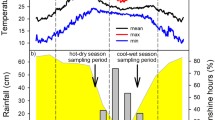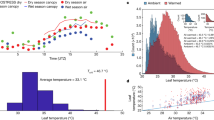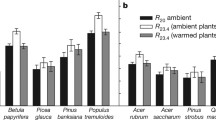Abstract
Tree crowns are spatially heterogeneous, sometimes resulting in significant variation in microclimate across the canopy, particularly with respect to temperature. Yet it is not known whether such localised temperature variation equates to intracanopy variation in leaf-level physiological thermal tolerance. Here, we studied whether microclimate variation across the canopy of a dominant desert tree equated to localised variation in leaf thermal thresholds (T50) among four canopy positions: upper south, upper north, lower south, lower north. Principal component analysis was used to generate a composite climatic stress variable (CSTRESS) from canopy temperature, vapour pressure deficit, and relative humidity. We also determined the average number of days that maximum temperatures exceeded the air temperature equating to this species’ critical threshold of 49 °C (AT49). To estimate how closely leaf temperatures track ambient temperature, we predicted the thermal time constant (τ) for leaves at each canopy position. We found that CSTRESS and AT49 were significantly greater in lower and north-facing positions in the canopy. Differences in wind speed with height resulted in significantly longer predicted τ for leaves positioned at lower, north-facing positions. Variation in these drivers was correlated with significantly higher T50 for leaves in these more environmentally stressful canopy positions. Our findings suggest that this species may optimise resources to protect against thermal damage at a whole-plant level. They also indicate that, particularly in desert environments with steep intracanopy microclimatic gradients, whole-plant carbon models could substantially under- or overestimate productivity under heat stress, depending on where in the canopy T50 is measured.


Similar content being viewed by others
References
Abdi H, Williams LJ (2010) Principal component analysis. Wiley interdisciplinary reviews: computational statistics 2:433–459
AGBoM (2013) Monthly climate statistics—Port Augusta. http://www.bom.gov.au/. Accessed 2013
AGBoM (2016) Wind roses for selected locations in Australia. Port Augusta. http://www.bom.gov.au/climate/averages/wind/selection_map.shtml. Viewed 14 March 2016
Amthor JS (1984) The role of maintenance respiration in plant growth. Plant Cell Environ 7:561–569. https://doi.org/10.1111/1365-3040.ep11591833
Aro E-M, Virgin I, Andersson B (1993) Photoinhibition of photosystem II Inactivation, protein damage and turnover. Biochim et Biophys Acta Bioenerg 1143:113–134. https://doi.org/10.1016/0005-2728(93)90134-2
Bauerle WL, Bowden JD, Wang GG (2007) The influence of temperature on within-canopy acclimation and variation in leaf photosynthesis: spatial acclimation to microclimate gradients among climatically divergent Acer rubrum L. genotypes. J Exp Bot 58:3285–3298
Bernacchi CJ, Rosenthal DM, Pimentel C, Long SP, Farquhar GD (2009) Modeling the temperature dependence of C3 photosynthesis. In: Laisk A, Nedbal L, Govindjee S (eds) Photosynthesis in silico: Understanding complexity from molecules to ecosystems. Springer, Dordrecht, pp 231–246
Bita CE, Gerats T (2013) Plant tolerance to high temperature in a changing environment: scientific fundamentals and production of heat stress-tolerant crops. Front Plant Sci 4:273. https://doi.org/10.3389/fpls.2013.00273
Curtis EM, Knight CA, Petrou K, Leigh A (2014) A comparative analysis of photosynthetic recovery from thermal stress: a desert plant case study. Oecologia 175:1051–1061
Curtis EM, Gollan JR, Murray BR, Leigh A (2016) Native microhabitats better predict tolerance to warming than latitudinal macro-climatic variables in arid-zone plants. J Biogeogr 43:1156–1165. https://doi.org/10.1111/jbi.12713
Eamus D (2006) Ecohydrology: vegetation function, water and resource management. CSIRO Publishing, Clayton
Engqvist L (2005) The mistreatment of covariate interaction terms in linear model analyses of behavioural and evolutionary ecology studies. Anim Behav 70:967–971
Farquhar GD, Sharkey TD (1982) Stomatal conductance and photosynthesis. Ann Rev Plant Physiol 33:317–345
Frak E et al (2002) Spatial distribution of leaf nitrogen and photosynthetic capacity within the foliage of individual trees: disentangling the effects of local light quality, leaf irradiance, and transpiration. J Exp Bot 53:2207–2216. https://doi.org/10.1093/jxb/erf065
Garson G (2013a) Factor analysis. Statistical Associates Publishers, Asheboro
Garson G (2013b) Generalized linear models/generalized estimating equations, 2013th edn. Statistical Associates Publishers, Asheboro
Gechev TS, Van Breusegem F, Stone JM, Denev I, Laloi C (2006) Reactive oxygen species as signals that modulate plant stress responses and programmed cell death. BioEssays 28:1091–1101
Georgieva K, Yordanov I (1994) Temperature dependence of photochemical and non-photochemical fluorescence quenching in intact pea leaves. J Plant Physiol 144:754–759
Havaux M, Greppin H, Strasser RJ (1991) Functioning of Photosystem I and Photosystem II in pea leaves exposed to heat—stress in the presence or absence of light: analysis using in-vivo fluorescence, absorbency, oxygen and photoacoustic measurements. Planta. https://doi.org/10.1007/bf00201502
Hikosaka K, Ishikawa K, Borjigidai A, Muller O, Onoda Y (2006) Temperature acclimation of photosynthesis: mechanisms involved in the changes in temperature dependence of photosynthetic rate. J Exp Bot 57:291–302. https://doi.org/10.1093/jxb/erj049
Hoffmann AA (1995) Acclimation: increasing survival at a cost. Trends Ecol Evol 10:1–1
IPCC (2014) Climate change 2014: mitigation of climate change. In: Edenhofer O, Pichs-Madruga R, Sokona Y, Farahani E, Kadner S, Seyboth K, Adler A, Baum I, Brunner S, Eickemeier P, Kriemann B, Savolainen J, Schlömer S, von Stechow C, Zwickel T, Minx JC (eds) Contribution of working group III to the fifth assessment report of the intergovernmental panel on climate change. Cambridge University Press, Cambridge, New York, pp 1–1435
Jongman RH, Ter Braak CJ, van Tongeren OF (1995) Data analysis in community and landscape ecology. Cambridge University Press, Cambridge
Katja H et al (2012) Temperature responses of dark respiration in relation to leaf sugar concentration. Physiol Plant 144:320–334. https://doi.org/10.1111/j.1399-3054.2011.01562.x
Knight C (2010) Small heat shock protein responses differ between chaparral shrubs from contrasting microclimates. J Bot. https://doi.org/10.1155/2010/171435
Knight C, Ackerly D (2002) An ecological and evolutionary analysis of photosynthetic thermotolerance using the temperature-dependent increase in fluorescence. Oecologia 130:505–514
Knight CA, Ackerly DD (2003a) Evolution and plasticity of photosynthetic thermal tolerance, specific leaf area and leaf size: congeneric species from desert and coastal environments. New Phytol 160:337–347
Knight CA, Ackerly DD (2003b) Small heat shock protein responses of a closely related pair of desert and coastal Encelia. Int J Plant Sci 164(1):53–60
Küppers M, Pfiz M (2009) Role of Photosynthetic Induction for Daily and Annual Carbon Gains of Leaves and Plant Canopies. In: Laisk A, Nedbal L, Govindjee S (eds) Photosynthesis in silico: understanding complexity from molecules to ecosystems. Springer, Dordrecht, pp 417–440
Lange R, Purdie R (1976) Western myall (Acacia sowdenii), its survival prospects and management needs. Rangeland J 1:64–69
Larkindale J, Hall J, Knight M, Vierling E (2005) Heat stress phenotypes of Arabidopsis mutants implicate multiple signaling pathways in the acquisition of thermotolerance. Plant Physiol 138:882–897
Leigh A et al (2012) Do thick leaves avoid thermal damage in critically low wind speeds? New Phytol 194:477–487
Leigh A, Sevanto S, Close J, Nicotra A (2017) The influence of leaf size and shape on leaf thermal dynamics: does theory hold up under natural conditions? Plant Cell Environ 40:237–248
Leroi AM, Bennett AF, Lenski RE (1994) Temperature acclimation and competitive fitness: an experimental test of the beneficial acclimation assumption. Proc Natl Acad Sci 91:1917–1921. https://doi.org/10.1073/pnas.91.5.1917
Lin Y-S (2012) How will Eucalyptus tree species respond to global climate change?–A comparison of temperature responses of photosynthesis, University of Western, Sydney
Loeschcke V, Hoffmann AA (2002) The detrimental acclimation hypothesis. Trends Ecol Evol 17:407–408. https://doi.org/10.1016/S0169-5347(02)02558-2
Macinnis-Ng C, Eamus D (2009) Climate change and water use of native vegetation. Research Report, Land & Water Australia, Canberra
Maconochie J, Lange R (1970) Canopy dynamics of trees and shrubs with particular reference to arid-zone topfeed species. Trans R Soc S Aust 94:243–248
Marias DE, Meinzer FC, Still C (2016) Leaf age and methodology impact assessments of thermotolerance of Coffea arabica. Trees:1–9
McVicar TR et al (2008) Wind speed climatology and trends for Australia, 1975–2006: capturing the stilling phenomenon and comparison with near-surface reanalysis output. Geophys Res Lett. https://doi.org/10.1029/2008gl035627
Meir P et al (2002) Acclimation of photosynthetic capacity to irradiance in tree canopies in relation to leaf nitrogen concentration and leaf mass per unit area. Plant Cell Environ 25:343–357. https://doi.org/10.1046/j.0016-8025.2001.00811.x
Melis A (1999) Photosystem-II damage and repair cycle in chloroplasts: what modulates the rate of photodamage in vivo? Trends Plant Sci 4:130–135
Miller G, Shulaev V, Mittler R (2008) Reactive oxygen signaling and abiotic stress. Physiol Plant 133:481–489
Mott JJ (1972) Germination studies on some annual species from an arid region of Western Australia. J Ecol 60:293–304. https://doi.org/10.2307/2258347
Murata N, Takahashi S, Nishiyama Y, Allakhverdiev SI (2007) Photoinhibition of photosystem II under environmental stress. Biochim et Biophys Acta Bioenerg 1767:414–421. https://doi.org/10.1016/j.bbabio.2006.11.019
Murray FW (1967) On the computation of saturation vapor pressure. J Appl Meteorol 6:203–204. https://doi.org/10.1175/1520-0450(1967)006<0203:OTCOSV>2.0.CO;2
Niinemets Ü (2007) Photosynthesis and resource distribution through plant canopies. Plant Cell Environ 30:1052–1071. https://doi.org/10.1111/j.1365-3040.2007.01683.x
Niinemets Ü (2012) Optimization of foliage photosynthetic capacity in tree canopies: towards identifying missing constraints. Tree Physiol 32:505–509. https://doi.org/10.1093/treephys/tps045
Niinemets Ü, Anten NPR (2009) Packing the photosynthetic machinery: from leaf to canopy. In: Laisk A, Nedbal L, Govindjee S (eds) Photosynthesis in silico: understanding complexity from molecules to ecosystems. Springer, Dordrecht, pp 363–399
Niinemets Ü, Valladares F (2004) Photosynthetic acclimation to simultaneous and interacting environmental stresses along natural light gradients: optimality and constraints. Plant Biol 6:254–268
Niinemets Ü, Oja V, Kull O (1999) Shape of leaf photosynthetic electron transport versus temperature response curve is not constant along canopy light gradients in temperate deciduous trees. Plant Cell Environ 22:1497–1513. https://doi.org/10.1046/j.1365-3040.1999.00510.x
Nobel PS (2012) Physicochemical and environmental plant physiology. Academic Press, New York
O’Sullivan OS, Weerasinghe KWLK, Evans JR, Egerton JJG, Tjoelker MG, Atkin OK (2013) High-resolution temperature responses of leaf respiration in snow gum (Eucalyptus pauciflora) reveal high-temperature limits to respiratory function. Plant Cell Environ 36:1268–1284. https://doi.org/10.1111/pce.12057
Pearcy RW, Björkman O, Caldwell MM, Keeley JE, Monson RK, Strain BR (1987) Carbon gain by plants in natural environments. Bioscience 37:21–29
Pearcy RW, Roden JS, Gamon JA (1990) Sunfleck dynamics in relation to canopy structure in a soybean (Glycine max (L.) Merr.) canopy. Agric For Meteorol 52:359–372. https://doi.org/10.1016/0168-1923(90)90092-K
Russell G, Marshall B, Jarvis PG (1990) Plant canopies: their growth. Cambridge University Press, Form and Function
Ryan MG (1991) Effects of climate change on plant respiration. Ecol Appl 1:157–167. https://doi.org/10.2307/1941808
Sack L, Melcher PJ, Liu WH, Middleton E, Pardee T (2006) How strong is intracanopy leaf plasticity in temperate deciduous trees? Am J Bot 93:829–839
Schrader SM, Wise RR, Wacholtz WF, Ort DR, Sharkey TD (2004) Thylakoid membrane responses to moderately high leaf temperature in Pima cotton. Plant Cell Environ 27:725–735. https://doi.org/10.1111/j.1365-3040.2004.01172.x
Stiegel S, Entling MH, Mantilla-Contreras J (2017) Reading the leaves’ palm: leaf traits and herbivory along the microclimatic gradient of forest layers. PLoS One 12:e0169741. https://doi.org/10.1371/journal.pone.0169741
Suzuki N, Mittler R (2006) Reactive oxygen species and temperature stresses: a delicate balance between signaling and destruction. Physiol Plant 126:45–51. https://doi.org/10.1111/j.0031-9317.2005.00582.x
Teskey R, Wertin T, Bauweraerts I, Ameye M, McGuire MA, Steppe K (2015) Responses of tree species to heat waves and extreme heat events. Plant Cell Environ 38:1699–1712. https://doi.org/10.1111/pce.12417
Vogel S (2009) Leaves in the lowest and highest winds: temperature, force and shape. New Phytol 183:13–26
von Caemmerer S, Farquhar G, Berry J (2009) Biochemical model of C 3 photosynthesis. In: Laisk A, Nedbal, L., Govindjee S (eds) Photosynthesis in silico: understanding complexity from molecules to ecosystems. Springer, Dordrecht, pp 209–230
Walter I et al (2005) ASCE’s standardized reference evapotranspiration equation. In: Allen R, Walter I, Elliott R, Howell T, Itenfisu D, Jensen M (eds) ASCE’s standardized reference evapotranspiration equation, pp 1–70
Warner TT (2009) Desert meteorology. Cambridge University Press, Cambridge
Whitford WG (2002) Ecology of desert systems. Elsevier Science, Amsterdam
World Wide Wattle V2 (2016) Acacia papyrocarpa Benth., Fl. Austral. vol 2, p 338 (1864). www.worldwidewattle.com. Accessed 2017
Zweifel R, Böhm JP, Häsler R (2002) Midday stomatal closure in Norway spruce—reactions in the upper and lower crown. Tree Physiol 22:1125–1136. https://doi.org/10.1093/treephys/22.15-16.1125
Zwieniecki MA, Boyce CK, Holbrook NM (2004) Hydraulic limitations imposed by crown placement determine final size and shape of Quercus rubra L. leaves. Plant Cell Environ 27:357–365. https://doi.org/10.1111/j.1365-3040.2003.01153.x
Acknowledgements
This project was undertaken as part of a research collaboration agreement between the University of Technology, Sydney and the Port Augusta City Council, South Australia, including support from the Friends of the Australian Arid Lands Botanic Gardens and nursery staff. The authors gratefully acknowledge the support of an Australian Wildlife Society grant to EMC for equipment. We also thank Ronda and Peter Hall, Dr, Brad Murray, Alicia Cook and staff at the UTS Workshop for technical assistance. This research was supported by an Australian Government Research Training Program Scholarship.
Author information
Authors and Affiliations
Contributions
AL and EMC generated hypotheses and designed the thermal tolerance work; EMC collected and analysed the data; CAK provided advice and contributed fundamental intellectual input; EMC led the writing, with AL revising the final text.
Corresponding author
Additional information
Communicated by Ylo Niinemets.
Electronic supplementary material
Below is the link to the electronic supplementary material.
Rights and permissions
About this article
Cite this article
Curtis, E.M., Knight, C.A. & Leigh, A. Intracanopy adjustment of leaf-level thermal tolerance is associated with microclimatic variation across the canopy of a desert tree (Acacia papyrocarpa). Oecologia 189, 37–46 (2019). https://doi.org/10.1007/s00442-018-4289-x
Received:
Accepted:
Published:
Issue Date:
DOI: https://doi.org/10.1007/s00442-018-4289-x




